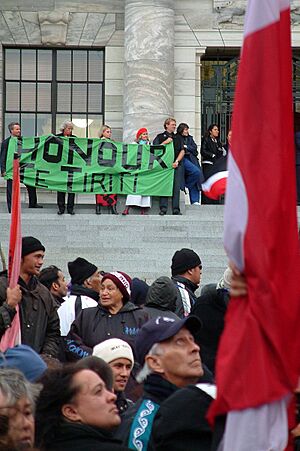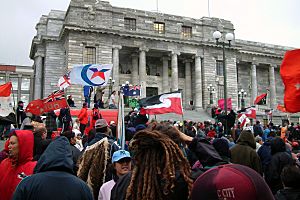New Zealand foreshore and seabed controversy facts for kids
The New Zealand foreshore and seabed controversy was a big debate in New Zealand politics. It was all about who owned the country's beaches and the land under the sea, called the foreshore and seabed. Many Māori groups said they had a right to own these areas because their ancestors had used them for a very long time. These claims were based on their history and the Treaty of Waitangi.
On 18 November 2004, the New Zealand Parliament passed a law saying that the Crown (which means the government) owned the foreshore and seabed. This law was called the Foreshore and Seabed Act 2004. It was later changed and replaced by a new law in 2011, called the Marine and Coastal Area (Takutai Moana) Act 2011.
Contents
Why the Debate Started
Court Says Māori Can Make Claims
In 1997, a group called Ngati Apa asked the Māori Land Court to say that the foreshore and seabed in the Marlborough Sounds was Māori customary land. The Māori Land Court thought it could look into this. But then, a higher court, the High Court, said no.
However, on 19 June 2003, the Court of Appeal made an important decision in a case called Ngati Apa v Attorney-General. The court said that the Māori Land Court could look into whether the foreshore and seabed were Māori customary land. This meant that Māori groups could try to prove their ownership rights in court.
Changing an Old Rule
This court decision changed an old rule from 1877, which had been supported in a 1963 case called Ninety Mile Beach. These old rules made it very hard for Māori to prove their land rights. They said that Māori land rights could be taken away easily, even by small parts of laws that didn't seem related.
The Court of Appeal said that "native property rights" (Māori land rights) should not be taken away easily. They said that any law taking away these rights needed to be very clear about it. The old Ninety-Mile Beach case had not followed this idea.
First Reactions to the Court Decision
The court's decision only meant that Māori could try to prove their claims. It did not mean they automatically owned the land. Experts thought it was unlikely Māori would get full ownership. But many people worried that Māori could now claim the entire New Zealand coastline.
New Zealanders have always had free access to beaches. Many people felt this access was now at risk. The Prime Minister at the time, Helen Clark from the Labour Party, said the government would make a law to keep the foreshore and seabed owned by everyone.
At the same time, the main opposition party, the National Party, led by Don Brash, attacked the government. They said the government's plans were too good for Māori. The government wanted the state to own the land, but also wanted to talk to Māori about how it was managed. The National Party said this gave Māori too much control and special rights.
The Waitangi Tribunal, which advises on Treaty of Waitangi issues, looked into the government's plans. They said the government's approach was unfair to Māori. The government disagreed, saying the Tribunal was questioning Parliament's power. The Attorney-General said the policy might seem unfair but was needed for a fair society. The Human Rights Commission disagreed, saying the law was unfair and not justified.
The Debate Continues
Even though many people disagreed with them, the government decided to go ahead with their law. They said their plan was the only way to solve the problem fairly. But criticism from both Māori and opposition parties grew, and the government started to lose support in public polls.
On 27 January 2004, National Party leader Don Brash gave a speech in Orewa. He strongly criticised the government, saying they were giving too much favour to Māori. Many Māori groups and the government did not like his speech. But many other New Zealanders supported him. His party also ran a successful campaign with billboards that said the Labour Party wanted to stop public access to beaches, while the National Party would protect the "Kiwi way of life." Soon after, the National Party became more popular than the Labour Party in polls.
The government also had problems within its own party. Many Māori Members of Parliament (MPs) in the Labour Party were unhappy with the proposed law. They thought about voting against it. This made the government unsure if they had enough votes to pass the law.
On 8 April 2004, the New Zealand First party said they would support the law. New Zealand First wanted the Crown to own the foreshore and seabed completely. This meant another party, United Future, which wanted the land to be owned by the "public at large," withdrew its support. But New Zealand First's votes were enough.
One of the strongest critics in the Labour Party was Tariana Turia, a junior minister. She said she might vote against the law. The Prime Minister made it clear that voting against a government law was not allowed for a minister. On 30 April, Tariana Turia announced she would vote against the law and leave the Labour Party. She was removed from her minister role that same day. Another Labour MP, Nanaia Mahuta, also voted against the bill but stayed in the Labour Party.
On 5 May 2004, a large protest march, called a hīkoi, arrived in Wellington. It had started in Northland thirteen days earlier and gathered many supporters along the way. Some people thought fifteen thousand people joined the hīkoi by the time it reached Parliament. The hīkoi strongly opposed the government's plans and supported Tariana Turia.
Tariana Turia and her supporters then started a new political party called the Māori Party. They believed it was time for Māori to have their own strong voice in politics.
The Law is Passed
On 18 November 2004, the Labour–Progressive government passed the Foreshore and Seabed Act 2004. This law said that the foreshore and seabed belonged to the Crown. However, Māori groups could apply for "guardianship" of certain areas. This law caused a lot of disagreement.

The government's bill passed its first vote in Parliament on 7 May 2004. Labour, the Progressives, and New Zealand First supported it. The National Party opposed it, saying it gave too much control to Māori. United Future opposed it because their idea of "public domain" was removed. ACT opposed it because they felt it took away Māori property rights. The Greens also voted against it, saying it ignored Māori rights. Tariana Turia and Nanaia Mahuta also voted against it. The vote was 65 in favour and 55 against.
Deputy Prime Minister Michael Cullen said the law would "safeguard the seabed and foreshore for everyone." But many people still strongly opposed the bill, and protests continued.
The bill then went to a special committee in Parliament to hear what the public thought. After six months, the committee could not agree and sent the bill back without any recommendations. The government made some small changes, and the bill passed its second vote on 17 November 2004 with the same number of votes. It finally passed its third and final vote on 18 November 2004. This time, Nanaia Mahuta voted in favour.
Later, on 15 December, the law was changed slightly. It was found that the law, as written, would have made all council-owned land reclaimed from the sea (like parts of Auckland and Wellington waterfronts) belong to the Crown. This was not what the law was meant to do.
The United Nations Committee on the Elimination of Racial Discrimination looked at the law. On 12 March 2005, they said the law was unfair to Māori. They said it stopped Māori from proving their traditional ownership of the foreshore and seabed and did not offer a way to fix this. Tariana Turia and the Māori Party saw this as a big win, but it did not change the government's policy.



